Adriana Xenides, who died this week aged 54 of a ruptured intestine, was a breath-takingly beautiful dark haired Argentian-born 17-year-old when her big break into modelling happened by chance.
Organisers of the annual Royal Show Wool Parades were in a spin when a top-name invited Italian model, co-incidentally also named Adriana, disgraced herself through over-indulgence, and was sent back home.
A local replacement had to be found immediately and Adriana Xenides, a local fledgling model, took her place.
She sashayed down the catwalk wearing her wide, warm smile, her luscious dark locks swinging sensually, and her Greek/Spanish good looks easily won the hearts of the audience. It was her big break and she swept into a modelling career.
I met Adriana a few years later in 1978, when she joined the inaugural Mrs South Australia Quest as an entrant raising funds for the then Crippled Children’s Association which I organised and she was, quite simply, unforgettable. An engaging brunette with a chatty, vivacious personality, the 22-year-old won the hearts of the judges and was named among the eight finalists, but was considered too young to carry the initial image of the married women’s quest.
However, Adriana found real fame when Grundy Television made her the glamorous blonde co-host of Wheel of Fortune, where her role was then the simplistic task of spinning a wheel to determine a letter – and she did it in spectacular style, winning the hearts of the nation for 18 long years. She became a TV star in 1981 when her long legs, stunning fashion sense and engaging style made her household name.
But, long-time friend Joan Lady Hardy recalls how Adriana was devastated when she lost her job.
“Her job there was her life and she created something out of what was really spinning letters, but she turned it into this amazing, theatrical experience…she gave a grand performance every single night and created her own little Hollywood.
“It was almost a fantasy world within that wheel of fortune,’’ says Lady Hardy.
In reward, her faithful audience adored her and voted her one of TV’s most loved icons, but when they switched the limelight off, Adriana’s own fortune took a body blow and she plunged into anonymity and clinical depression. She never quite got back on her feet.
“Adriana felt so secure in that show and had never looked beyond to where she might be in, say, five years time, because she thought it would never end,’’ says Lady Hardy.
Her personal life was a never-ending sad saga with three marriages and divorces, a high profile broken engagement with Tom Hardy, a relative of Lady Hardy’s, a controversial serious car accident, scrapes with the law, chronic ill-health and clinical depression.
After the breakup, Lady Hardy and Adriana continued their long friendship through letter-writing.
“She wrote such lovely letters and one of them was 17 pages long,’’ says Lady Hardy.
“Another letter explained why the breakup happened and I replied “there is no way I am taking sides here’ and she appreciated that and we had a friendship which lasted far beyond that period of her life.’’
Despite an extended term in hospital receiving treatment for clinical depression, she recovered to appear on some small screen guest appearances on Celebrity Big Brother and Beauty and the Beast, but Adriana never worked full time in television again.
The final, sad chapter in her life ended a decade of deteriorating poor health when she died from a ruptured intestine on Monday afternoon. Her faithful friend, Michael Shepherd, who had been publicity manager for Channel 7, recalls how she endured years of pain. She once described the pain in her abdomen as “so hard it takes you down to your knees’’. She was taken by ambulance on Sunday afternoon, her stomach swollen to twice its size and as hard as concrete. She died 20 minutes before Michael reached her on Monday afternoon.
“They opened her up and closed her up again saying there was nothing they could do. Burg (John Burgess former co-host of Wheel of Fortune) got there before she died, but she was heavily sedated,’’ he says.
“She was in regular pain management and despite it all, she was trying desperately to give her life meaning,’’
My vivid memory is of vivacious Adriana as an enthusiastic quest entrant, with a loving husband and it is sad to accept that her life for 30-odd years thereafter unfolded as one big emotional heartache.
“We are victims of our own decisions and she did make some bad decisions when it came to men and relationships,’’ says Michael. “Some took advantage of her generosity. She once said to me ‘Have I got a sign on my forehead which says “Idiots welcome’!’’.
One of the saddest moments of her life was when her beloved Spanish mother, Conseula, died in her arms in September 2003. Michael says she never recovered fully from her loss.
“We met in the1990, when I came to Adelaide with the Home and Away actors,’’ says Michael who is now publicity director for TV1 and thee Sci-Fi channel for Foxtel.
“We have always had a great brother sister-type relationship.
“There were times when she was Oh God beside herself with monumental problems, but she had just graduated from a course in makeup for film and television and she was going to start working behind the scenes.’’
“Adrie’’, as Michael calls her, suffered not only excruciating pain, but also from an aching loneliness. It triggered her depression.
“She would text me at, say 2am in the morning and say “Do you feel like a chat?’’
As her relatives lay her to rest in peace at a private ceremony in Sydney on Friday, my own thoughts on our fallen star matches those of Lady Hardy.
“Once met, you don’t’ forget people like Adriana,’’ concludes Lady Hardy.
“Yet, hers was a very lonely life; I don’t think her depression ever left her.’’
The tragedy was that Adriana was living alone, without a partner, no children and surviving on a government pension when she died. Yet she was still trying so hard to find a meaningful role for herself in life.
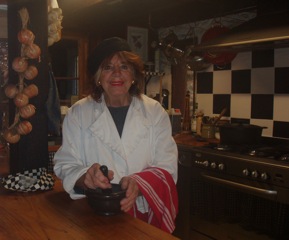 “Hey, I feel French!’’,’’ says Christine.
“Hey, I feel French!’’,’’ says Christine.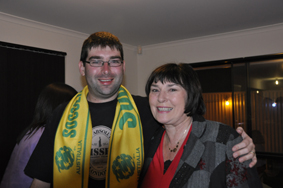 If there is such a moment, it must be now that my son, my youngest child, Tyson turned 30, a milestone we celebrated with a fabulous, noisy party for family and friends last Saturday.
If there is such a moment, it must be now that my son, my youngest child, Tyson turned 30, a milestone we celebrated with a fabulous, noisy party for family and friends last Saturday.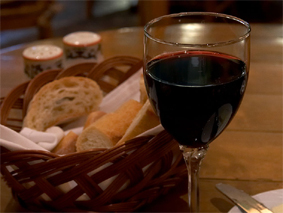 Among one number is an eastern suburbs GP with a focus on men’s health and another fellow, a singer in a local band, has not drunk a drop of alcohol all night and he has watched us consume a fine array of Australian red and white wines. This has been an exciting informal wine appreciation course because our host is an associate professor of wine and viticulture, an author and a consultant to the industry. We had begun with a bubbly Bird In Hand sparkling wine (Adelaide Hills), and a crisp O’Leary and Walker Watervale Riesling 2008, and continued with a Richmond Grove Shiraz 2001. Our own contribution had been a Yering Station Shiraz 2007.
Among one number is an eastern suburbs GP with a focus on men’s health and another fellow, a singer in a local band, has not drunk a drop of alcohol all night and he has watched us consume a fine array of Australian red and white wines. This has been an exciting informal wine appreciation course because our host is an associate professor of wine and viticulture, an author and a consultant to the industry. We had begun with a bubbly Bird In Hand sparkling wine (Adelaide Hills), and a crisp O’Leary and Walker Watervale Riesling 2008, and continued with a Richmond Grove Shiraz 2001. Our own contribution had been a Yering Station Shiraz 2007. When I was a young child visiting Grandma, the sweetest moments were when the train would clickety-clack past the front gate along the Islington line. I would swing from the gate, all bobby socks and long plaits, waving furiously to the engine driver.
When I was a young child visiting Grandma, the sweetest moments were when the train would clickety-clack past the front gate along the Islington line. I would swing from the gate, all bobby socks and long plaits, waving furiously to the engine driver.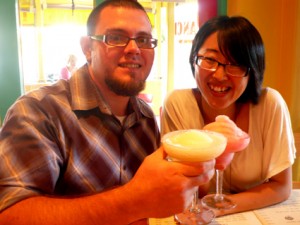 Oldest grandson Andre, a solidly built 27-year-old fine arts student from Charles Darwin University has flown in from Darwin to transfer to UniSA with his Korean girlfriend, Saelim in tow. They are lively company with conversation filled with their dreams of success and plans to find a house, get a car and establish themselves supplementing a student allowance at Adelaide craft markets. He hopes to become a sculptor and comes here on a remote area government scholarship with a glowing reference from Darwin’s Arts Faculty. The first step in this endeavour is to borrow one of our cars and it becomes a familiar sight to see my Mazda 323 disappear down the driveway as they house-hunt and job-hunt and handle university paperwork. His enthusiasm is our joy, too, when he is accepted at Uni and we celebrate with cocktails at Montezuma’s Mexican restaurant.
Oldest grandson Andre, a solidly built 27-year-old fine arts student from Charles Darwin University has flown in from Darwin to transfer to UniSA with his Korean girlfriend, Saelim in tow. They are lively company with conversation filled with their dreams of success and plans to find a house, get a car and establish themselves supplementing a student allowance at Adelaide craft markets. He hopes to become a sculptor and comes here on a remote area government scholarship with a glowing reference from Darwin’s Arts Faculty. The first step in this endeavour is to borrow one of our cars and it becomes a familiar sight to see my Mazda 323 disappear down the driveway as they house-hunt and job-hunt and handle university paperwork. His enthusiasm is our joy, too, when he is accepted at Uni and we celebrate with cocktails at Montezuma’s Mexican restaurant.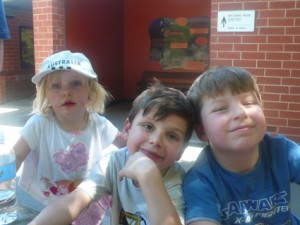 Women not only win the hearts of men through their stomachs, the kitchen is the place to make one’s mark as a good grandma. As I don an apron, I thank my own departed mother who would cook for hours for her 13 grand-children producing trayloads of biscuits, cakes, tarts or sausage rolls. So, I make pastry for lemon tarts and quiches and they knead the dough. I make stuffing for the duck before my chatting audience. “Let me stuff the duck,’’ says Samuel and I patiently watch as he fills the cavity with a sense of pride. “You will make a good chef,’’ I tell him. Praise wins the youngest of hearts. They are like the magpies outside on the lawn, mouths open waiting for food, fridge door swinging off its hinges, incessant questions, all against the drone of the washing machine.
Women not only win the hearts of men through their stomachs, the kitchen is the place to make one’s mark as a good grandma. As I don an apron, I thank my own departed mother who would cook for hours for her 13 grand-children producing trayloads of biscuits, cakes, tarts or sausage rolls. So, I make pastry for lemon tarts and quiches and they knead the dough. I make stuffing for the duck before my chatting audience. “Let me stuff the duck,’’ says Samuel and I patiently watch as he fills the cavity with a sense of pride. “You will make a good chef,’’ I tell him. Praise wins the youngest of hearts. They are like the magpies outside on the lawn, mouths open waiting for food, fridge door swinging off its hinges, incessant questions, all against the drone of the washing machine.